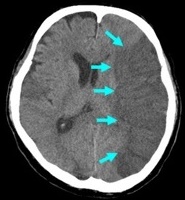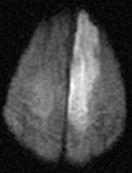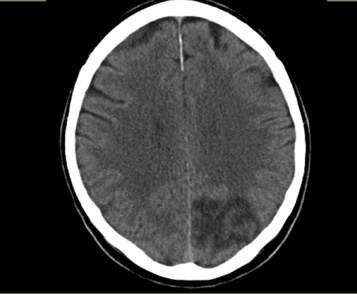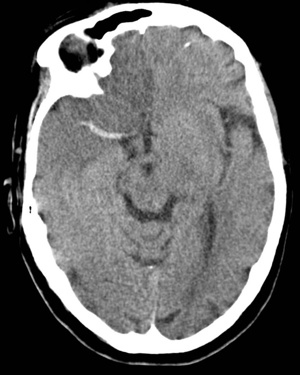Imaging patterns to know and recognise
Acute Ischaemic Stroke
- T2 Weighted Imaging and FLAIR show increased signal 'bright' which peaks at 7 days and may persist for a month.
- Diffusion weighted imaging is the most sensitive sequence for acute ischaemia as it shows the diffusion restriction (reduced brownian motion) of extracellular water due to imbalance caused by cytotoxic oedema within minutes. It can remain bright for up to 3 weeks. Some of the bright area may be viable. Vasogenic oedema can also give a bright appearance. Chronic Infarction is not bright on DWI.
- ADC map is initially 'dark' low signal with cytotoxic oedema (acute ischaemic stroke) and then increases in signal later on. Vasogenic oedema increases water diffusion and gives a bright appearance on the ADC map and this is called 'T2 shine through'. With time the DWI shows decreased signal intensity and the ADC shows increased ADC values.
- Gradient echo or T2 star It may also be useful in the very early detection of acute thrombosis and occlusion involving the middle cerebral (MCA) or internal carotid artery (ICA). This may show as a hypointense (dark) signal within the MCA or ICA, often in a curvilinear shape. Note that the diameter of the hypointense signal is larger than that of the contralateral unaffected vessel. This finding is called the susceptibility sign, and it is analogous to the hyperdense MCA sign described for CT imaging.
- Perfusion weighted imaging requires fast MRI techniques to quantify the amount of MR contrast agent reaching brain parenchyma after an IV bolus. Allows construction of maps of cerebral perfusion. This can show ischaemic zone.
- There has been increased using MR as a guide to salvageable tissue using the difference in the volume of brain with restricted diffusion in the DWI and that with high signal in the flair. When haemorrhage is suspected the sequence of choice is MRI with Gadolinium
Cardioembolic stroke
- Typically large vessel stroke or strokes
- Multiple lesions : Anterior and posterior circulation and bilateral
- Strokes of different age
Lacunar Stroke
- Typically < 1.5 cm diameter usually subcortical hypodensity
- Within thalamus, caudate, entire subcortex and brainstem especially pons
- Occluded small penetrating arteries
Basilar Artery Occlusion
- Hyperdense Basilar artery in front of pons
- Confirm with MRA/CTA/DSA
Carotid Dissection
- Axial Use Fat suppression T2 shows cross section of artery with thrombus
- CTA/DSA or CEMRA shows vessel with obstruction or subtotal obstruction
- MRI or CT may show downstream infraction from occlusion or thromboembolism
Cerebral/Vertebral venous sinus thrombosis
- Generalised parenchymal oedema
- Cerebral Haemorrhage
- Cerebral infarction which does not fit to typical arterial territory
- Thrombus may be seen even on NCCT within occluded sinuses and veins
- Empty sinus or Delta sign - may be seen on CT images post contrast. The sign consists of a triangular area of enhancement or high attenuation with a relatively low-attenuating centre on multiple contiguous transverse CT images obtained in the region of the superior sagittal sinus
CADASIL
- CT may be normal or show mild to advanced periventricular small vessel disease
- Multiple areas white matter T2-hyperintensity and lacunar infarctions concentrated in the anterior temporal lobes and in the deep white matter of the frontal and parietal lobes. There is relative sparing of the occipital lobes.
- Anterior temporal pole and external capsule lesions have higher sensitivity and specificity for CADASIL.
- A DSA is typically normal not identifying any significant large vessel disease.
Primary angiitis of the CNS
- The Digital subtraction angiogram or CEMRA shows lumen irregularities in distal cerebral arteries.
MELAS syndrome
- CT shows widespread infarct like lesions
- MR shows multiple cortical and subcortical infarct-like lesions that cross vascular boundaries
- Lesions are most prominent in the parieto-occipital region and basal ganglia.
- Lesions have a migrating pattern over time, with appearance, disappearance, and reappearance.
- Variable degrees of generalised cerebral and cerebellar atrophy may also be seen.
- Basal ganglia calcifications may also be seen.
- CTA and MRA are usually normal.
- DSA in the acute phase may show dilated cortical arteries with prominent capillary blush and no arterial occlusion.
Posterior reversible encephalopathy syndrome (PRES)
- Marked cerebral oedema which is often widespread
- Focused predominately in the cortical and subcortical grey matter of the parietal and occipital regions but may also be seen in frontal and inferior temporal-occipital junction and cerebellum.
- MRI (DWI) has shown that the areas of abnormality represent vasogenic oedema which follows arterial territories
- DSA has shown diffuse vasoconstriction as well as focal vasoconstriction, vasodilation, and even a string-of-beads appearance consistent with vasospasm or arteritis.
- There is reduced brain perfusion in regions of PRES.
Imaging Patterns in Haemorrhagic Stroke
Hypertensive haemorrhage
- Gradient echo or T2 star. This can show up bleeds especially small microbleeds
- Location of Bleeds in putamen, thalamus, and pons.
- Microbleeds may also be found in the basal ganglia, thalamus, or pons
Cerebral Amyloid angiopathy
- Gradient echo or T2 star can show up bleeds especially small microbleeds
- Haemorrhages more likely to occur in the temporal and occipital than the frontal and parietal lobes and sites of previous bleeds. There was a slight bias for the posterior circulation.
- Cerebellum can also be affected.
- Microbleeds as small as 2 mm may be found on GRE or T2*. Gradient-echo MRI may also show by iron-containing deposits left by old haemorrhages
Other relevant imaging Diagnoses
Non Communicating Hydrocephalus
Radiology of choice is Midsagittal MRI which reveals the drainage pathway in great detail
- Normal - Lateral ventricles small and 3rd ventricle barely visible
- Single lateral ventricle dilated (Univentricular hydrocephalus) = Obstruction of one foramen of munro
- Both lateral ventricles dilated (Biventricular) = Obstruction of both foramen of munro
- Dilation of Lateral + 3rd Ventricle (Triventricular) = Obstruction at level of aqueduct
- Dilation of Lateral + 3rd + 4th = Obstruction at foramen of Magendie and Luschka
Communicating Hydrocephalus
- All ventricles are modestly dilated.
- Prominent Subarachnoid spaces and basal cisterns
Some Images

Left MCA Infarct

DWI of an Anterior cerebral artery infarct

CT of Left Posterior cerebral artery infarct

Dense MCA artery sign
| Note: The plan is to keep the website free through donations and advertisers that do not present any conflicts of interest. I am keen to advertise courses and conferences. If you have found the site useful or have any constructive comments please write to me at drokane (at) gmail.com. I keep a list of patrons to whom I am indebted who have contributed. If you would like to advertise a course or conference then please contact me directly for costs and to discuss a sponsored link from this site. |